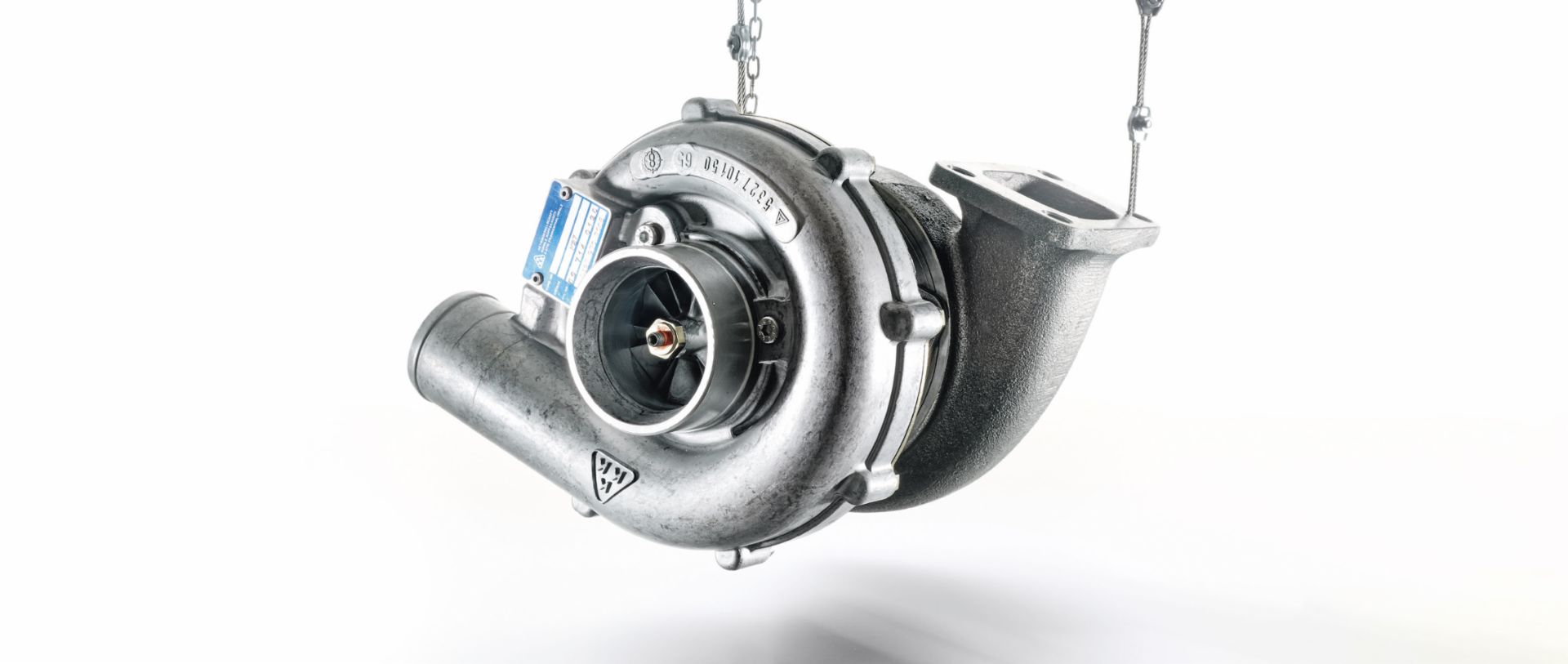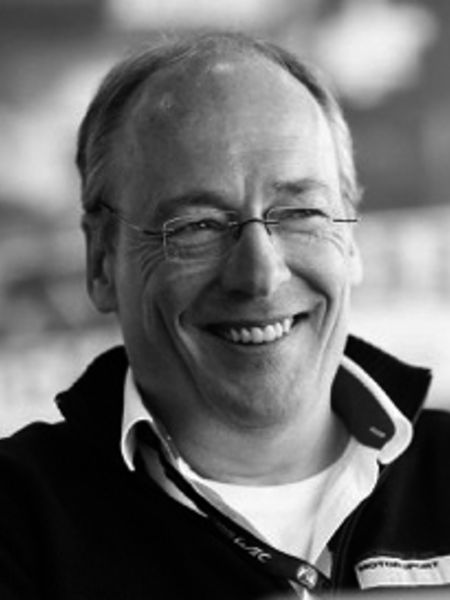Under Pressure
The term “turbo” was once a synonym for brute power delivery. Today, turbocharged engines set standards in terms of fuel efficiency and smoothness.
Porsche 911 Turbo S Coupé
Fuel consumption
City: 15.5 l/100 km
Highway: 8.6 l/100 km
Combined: 11.1 l/100 km
CO2 emissions combined: 254 g/km (as of 03/2020)
Visually it resembles a snail’s shell, but it makes engines move a lot faster than that! Since the early seventies, Porsche has put its trust in turbochargers as a means of increasing performance. In 1973 the technology passed its motorsport baptism of fire with flying colors on board the powerful 917/30: with over 809 kW (1,100 hp), the open two-seater left its opponents in the North American CanAm racing series far behind. Just one year later, the technology—unique among sports cars back then—celebrated its debut in a series-production Porsche. With the 911 Turbo, initially developing up to 191 kW (260 hp), the brand finally joined the elite circle of manufacturers of high-performance sports cars.
To begin with, Porsche had only planned for five hundred units of the 930 series—as it was known internally—for it was the number of units required for motorsport homologation. The pleasingly high demand for the broad-cheeked bundle of muscles with the mighty rear wing caused a quick rethink. In 1977 the first enhancement was made to the 911 Turbo—its displacement was increased from 3.0 to 3.3 liters and its output rose to as much as 220 kW (300 hp). Apart from some smaller modifications, the 930 remained in the product range almost unchanged until 1988. It laid the groundwork for a turbo success story that’s currently starting its latest chapter with the 992 generation of the 911.
The basic principle of increasing performance by means of a turbocharger still applies today: after ignition and the power stroke, the burnt mixture escapes into the exhaust system via the exhaust valves at such high pressure that it can drive a turbine at high speeds. A shaft connects the turbine to a compressor wheel, which in turn scoops more fresh air into the combustion chamber on the intake side, thus ensuring more efficient combustion. So far, so simple.
But the technology is not without its drawbacks. For one, there are the high temperatures that the turbocharger can reach. The spiral-shaped turbine housing can heat up to a good 1,000 degrees Celsius and must be shielded accordingly—on the compressor side as well. Ideally, the charge air should not be more than twenty degrees warmer than the ambient temperature before entering the cylinder. If the difference is greater, the air loses too much density, which impairs the combustion process. Boost control and pressure build-up have also presented challenges.
Turbo development has made great strides since 1974, largely thanks to Porsche. Over the decades, Zuffenhausen has come to see the term “turbo” as synonymous with leading technology. The top model of every 911 generation has borne the word in its name. The technology has established itself as particularly efficient and low-emission while also being very cultivated. Perhaps the most impressive achievement is that the turbo engines have reached the level of much larger, naturally aspirated engines, even in terms of their responsiveness. Porsche has succeeded in taming the legendarily explosive power delivery.
Porsche 911 Turbo (930)
Even the turbocharger of the 1974 ancestor had an exhaust-gas overpressure valve (wastegate), something that was previously only familiar from racing cars. With a maximum boost pressure of 0.8 bar, it develops 191 kW (260 hp), but the thrust kicks in somewhat abruptly at 3,500 rpm. In 1977 the 221 kW (300 hp) successor appeared with a larger compressor wheel and—at that time another novelty for passenger cars—an intercooler for the compressed air.
Design type: turbo
Displacement: 3,299 cm3
Max. charge pressure: 0.8 bar
Output: 300 hp
Max. torque: 412–430 Nm
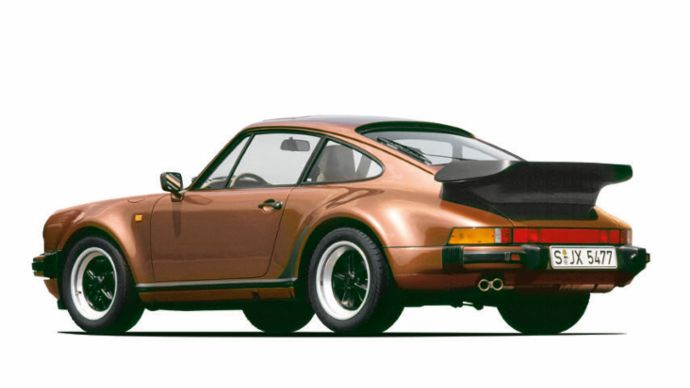

Porsche 959
Porsche demonstrated the future potential of turbo technology with the 959, which was first presented at the IAA in 1983 as the Group B study and was launched three years later as a road version. The all-wheel-drive super sports car has a complex sequential boosting system with two different-sized turbochargers. The smaller one responds at lower engine speeds. Added to this is an electronic boost control system, developed by Porsche. The four-valve engine also sports water-cooled cylinder heads.
Design type: twin-turbo (sequential)
Displacement: 2,850 cm3
Max. boost pressure: 1.0 bar
Output: 450 hp
Max. torque: 500 Nm
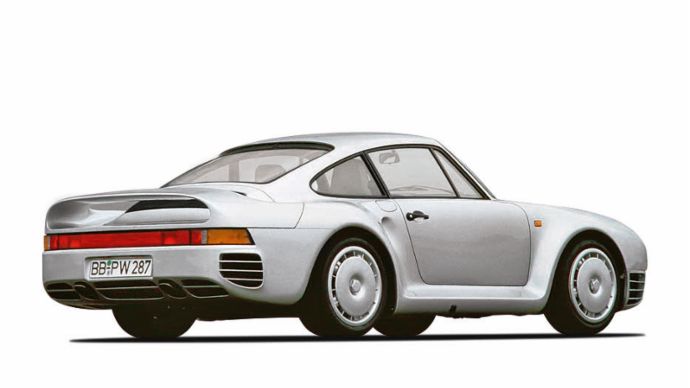
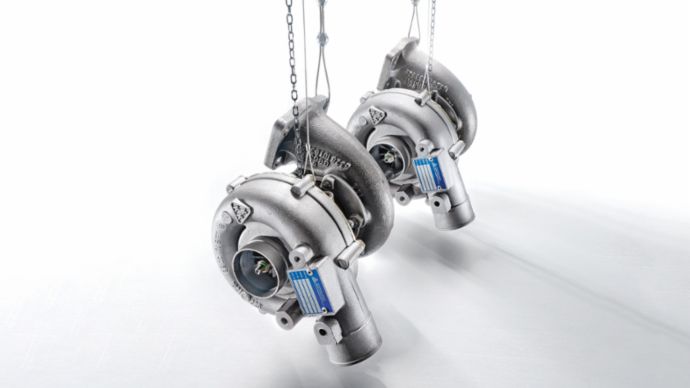
The 959 is the art of the technically possible.
Porsche 911 Turbo 3.3 (964)
The 911 Turbo of the 964 generation, with 235 kW (320 hp), initially adopted the 3.3-liter engine of its predecessor in 1991. Thanks to complex exhaust-gas aftertreatment with three-way metal catalytic converters and an additional catalytic converter for the bypass outlet, it met increasingly stringent emission standards. Pressure-controlled characteristic map injection and a fifty percent larger charge-air cooler were added as well. A 3.6-liter version followed in 1993—now with 265 kW (360 hp) but better fuel economy.
Design type: turbo
Displacement: 3,299 cm3
Max. boost pressure: 0.8 bar
Output: 320 hp
Max. torque: 450 Nm

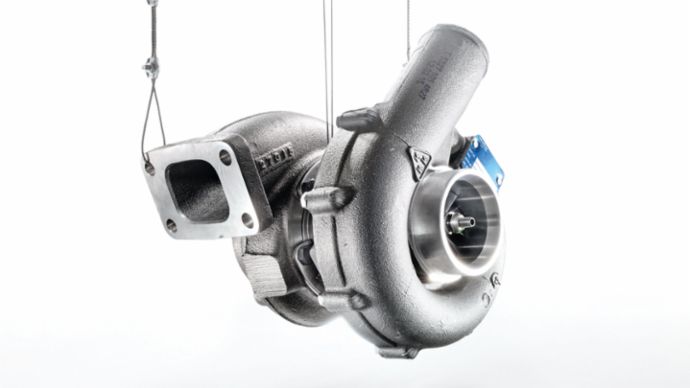
Porsche 911 Turbo (993)
In 1995 Porsche presented the 911 Turbo of the last air-cooled generation—993. It was the first time Porsche relied on the power of two turbochargers in a series-production model. Unlike the 959, however, they were not sequential, but worked in parallel. They each supplied one cylinder bank of the 3.6-liter six-cylinder engine with charge air. The wastegate integrated in the turbo was also new. This 911 Turbo was the lowest-emission vehicle of its time, and from 1997 the same applied to the Turbo S. In its most radical, motorsport-inspired version, the 911 GT2, its output can reach up to 330 kW (450 hp).
Design type: twin-turbo (parallel)
Displacement: 3,600 cm3
Max. charge pressure: 0.8 bar
Output: 408 hp
Max. torque: 540 Nm


Porsche 911 Turbo S (996)
The 996 generation, introduced in 1997, and its turbo version, introduced in 2001, marked a new beginning: all engines, including the new 3.6-liter turbo, were now liquid-cooled. The Turbo and Turbo S (as of 2004) had VarioCam Plus, an adjustment of the intake camshaft including valve lift switching of the intake valves. The turbo engine was based on the powertrain of the 1998 Le Mans victor, the 911 GT1. Standard on the Turbo S model: Porsche Ceramic Composite Brakes (PCCB). Tiptronic S was available on request. The S owes its 330 kW (450 hp) to larger turbochargers, more efficient charge-air coolers, and modified catalytic converters.
Design type: twin-turbo (parallel)
Displacement: 3,600 cm3
Max. charge pressure: 0.9 bar
Output: 450 hp
Max. torque: 620 Nm


In the 996 as in the 993, two turbochargers work in parallel.
Porsche 911 Turbo (997)
The 997 generation 911 Turbo surprised everyone in 2006 with a world first: Porsche had combined a gasoline vehicle with so-called VTG—variable turbine geometry. This means different angles of attack for the guide vanes. At low engine speeds, the vanes stand more upright in the exhaust stream and therefore respond sooner. Although already established in diesel engines, the VTG principle for the gasoline engine of the 911 Turbo had to be developed practically from scratch. The much higher temperatures compared to a diesel engine required materials from the aerospace industry.
Design type: twin-turbo (parallel)
Displacement: 3,600 cm3
Max. charge pressure: 1.0 bar
Output: 480 hp
Max. torque: 620 Nm with overboost control


Porsche 911 Turbo S (992)
Turbo development has reached new heights in the 992 generation. The new engine of the 911 Turbo S combines wastegates with VTGs—with the difference that now they’re mirror images of each other and even larger. The advantage to this innovation is that, after a cold start, the catalytic converters heat up more quickly because they’re warmed up directly via the electronically controlled bypasses. There are benefits to efficiency as well: the exhaust back pressure is automatically reduced when operating at full load, which reduces the residual gas in the cylinder that interferes with combustion.
Design type: twin-turbo (parallel)
Displacement: 3,745 cm3
Max. charge pressure: 1.4 bar
Output: 640 hp
Max. torque: 800 Nm


